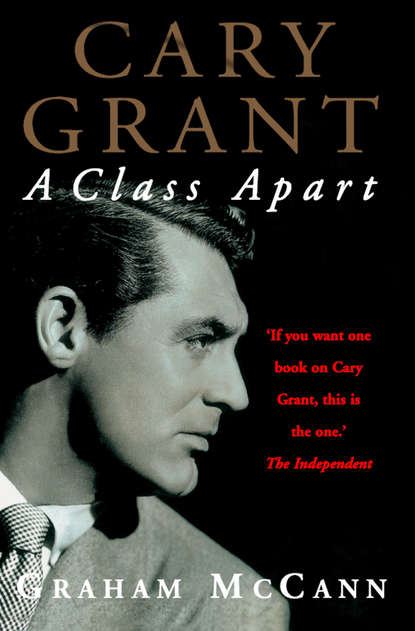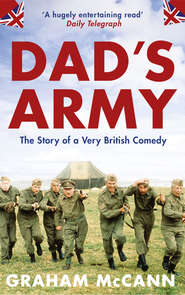По всем вопросам обращайтесь на: info@litportal.ru
(©) 2003-2024.
✖
Cary Grant: A Class Apart
Настройки чтения
Размер шрифта
Высота строк
Поля
(#litres_trial_promo) The memories of Hollywood celebrities are notoriously unreliable: as the call to work with West came some months after Grant had finished Blonde Venus, von Sternberg’s role in the advancement of Grant’s ‘stellar career’ was somewhat overstated. West claimed in her (equally unreliable) autobiography, Goodness Had Nothing To Do With It, that she noticed ‘a sensational looking young man’ – Grant – on the Paramount lot, and cast him on the spot: ‘If this one can talk,’ she claims she said at the time, ‘I’ll take him.’
(#litres_trial_promo) According to West, she saw immediately that Grant ‘had poise, a great walk, everything women would like’.
(#litres_trial_promo) In truth, Grant was probably first spotted by West on the screen in one of his earlier movie appearances (‘I liked his voice first, but I saw right away that the rest of him measured up’
(#litres_trial_promo)). As far as his casting for She Done Him Wrong was concerned, it seems likely that B. P. Schulberg had favoured pairing his new leading man with the aggressive West,
(#litres_trial_promo) and it is also known that Lowell Sherman, the director West had chosen for the movie, had liked Grant’s performance in Blonde Venus.
(#litres_trial_promo)
The movie was an adaptation of West’s stage success of 1928, Diamond Lil. She played Lady Lou, ‘one of the finest women who ever walked the streets’, who runs a Bowery saloon; Grant played Captain Cummings, from the nearby church mission, who is really ‘the Hawk’, a government agent. It was the first opportunity since Grant had been in Hollywood for him to make use of his vaudeville training as a straight man. ‘Haven’t you ever met a man who can make you happy?’ he asks her. ‘Sure,’ she replies, ‘lots of times.’ West had usually played opposite men who appeared as tough and as coarse as her own character, and Grant’s more vulnerable performance provided an interesting contrast to her brash sexuality. ‘Why don’t you come up sometime, see me?’ she says to him, staring into his eyes. ‘Come up. I’ll tell your fortune.’
Shooting began on 21 November 1932, and was completed in a mere eighteen days. For an outlay of $200,000, it earned $2 million within three months in the US alone. This movie, in effect, saved Paramount from bankruptcy. Cary Grant emerged from the triumph as someone who had the potential to be much more than a mere straight man to Mae West. As Pauline Kael observes, West brought out Grant’s passivity, giving him an aloof charm, ‘a quality of refinement in him which made her physical aggression seem a playful gambit’.
(#litres_trial_promo) Kael also noted that the success of the performance was achieved in spite of Grant’s relative lack of confidence in his own abilities as a movie actor: he did not ‘yet know how the camera should see him’, and he appeared, when he had little to do in a scene, ‘vaguely ill at ease’, standing ‘lunged forward as if hoping to catch a ball’
(#litres_trial_promo) (this might be a little unfair: Grant’s character was meant to seem uneasy in his duplicity, and his physical awkwardness provided West with the opportunity for yet more double entendres: ‘That’s right. Loosen up. Unbend. You’ll feel better’). He was, none the less, the ‘classiest’ leading man whom West had appeared with, and the critics appreciated that fact. ‘Hi, tall, dark and handsome,’ she said to him; it was a nice welcome for Cary Grant. His good looks, under-playing and good comic timing combined to suggest a very promising future. After roles in three more formulaic movies – The Woman Accused, The Eagle and the Hawk and Gambling Ship (all 1933) – Paramount seized on the opportunity to cast Grant alongside West for their second movie together: I’m No Angel. The weak story-line never threatened to distract one’s attention from the comic dialogue:
Grant: Do you mind if I get personal?
West: I don’t mind if you get familiar.
Although it was a poor movie in comparison with She Done Him Wrong, it was another great success at the box-office. Paramount raised his salary to $750 per week. Fan mail began to arrive in increasing amounts, and the fan magazines started to compete for his interviews.
(#litres_trial_promo)
He was grateful for the exposure afforded him by his association with West – who was among the top ten box-office attractions in the country at that time – but he became increasingly resentful of the shameless way in which she sought to take all of the credit for his stardom: ‘She always got a great deal of publicity for herself … I could never understand the woman. I thought she was brilliant with that one character she portrayed, but she was an absolute fake as a person. You would shudder from it.’
(#litres_trial_promo) At the time, however, Grant – who thought more than most about the technique behind a performance – was well aware of what an excellent teacher in the art of screen comedy West was: ‘She knows so much … Her instinct is so true, her timing so perfect, her grasp of the situation so right. It’s the tempo of the acting that counts rather than the sincerity of the characterisation. Her personality is so dominant that everyone with her becomes just a feeder.’
(#litres_trial_promo) One of the most impressive qualities of the young Cary Grant was this capacity for quiet observation; he never missed an opportunity to learn from performers more experienced, and more skilled, than himself, and he learned much of immense value from his working experience with Mae West.
Grant was now in the process of becoming something of a Hollywood celebrity. He inherited the dressing-room formerly occupied by George Bancroft, a star of silent movies who had recently been demoted to the ranks of supporting players. Paramount’s most illustrious top dozen stars were quartered side by side in implied order of importance. Mae West had taken possession of dressing-room number 1, followed by the other leading women: Claudette Colbert, Marlene Dietrich, Sylvia Sidney, Miriam Hopkins and Carole Lombard. Then came the leading male stars: Gary Cooper, Fredric March, Bing Crosby, George Raft, Cary Grant and Charles Laughton. Grant’s personal life was also beginning to change: he became engaged in 1933 to Virginia Cherrill, who had played the blind girl in Chaplin’s City Lights, and in November he took her back to England,
(#litres_trial_promo) where they were married on 9 February the following year. He was thirty years old. The marriage, however, was soon in trouble; in the spring of 1935 they separated, and Grant began a series of brief relationships with other women.
(#litres_trial_promo) The couple were granted a divorce that March.
Professionally, the years 1934 and 1935 did not see Grant offered many movie roles by Paramount which provided him with much opportunity to exploit his new-found popularity. Thirty Day Princess, Born to Be Bad, Kiss and Make Up, Ladies Should Listen (all 1934) were largely forgettable affairs. After making Wings in the Dark (1935), Grant was given six months off; Paramount had a backlog of Grant movies which had yet to be released.
(#litres_trial_promo) It seemed as though the studio was undecided as to how best it should utilise his talents, and his dissatisfaction with Paramount deepened: ‘They had a lot of leading men at Paramount with dark hair and a set of teeth like mine, and they couldn’t be buying stories for all of us.’
(#litres_trial_promo) In November 1935 he returned to England to make The Amazing Quest of Ernest Bliss
(#litres_trial_promo) for the independent company, Garrett Klement Pictures; if he had hoped to find temporary relief away from Hollywood, he was disappointed – during the filming, his father died.
When Grant returned to Hollywood early in 1936 he was anxious to sort out his future. He feared that he was in danger of being eclipsed by some of his contemporaries, such as James Cagney (who had just reached number ten in the list of top box-office draws) and Errol Flynn (who had starred recently in the very successful Captain Blood). It had become obvious to insiders that Grant was unhappy at Paramount. When Sylvia Scarlett, which he had made on loan at RKO the previous year, was released, the generally positive reviews of his contribution encouraged him to persevere in his struggle for more control over his career.
Grant later acknowledged Sylvia Scarlett as ‘my breakthrough’,
(#litres_trial_promo) but it was, in many ways, a spectacular failure. Based on Compton Mackenzie’s picaresque novel, it starred Katharine Hepburn and was directed by George Cukor. Grant played Jimmy Monkley (‘gentleman adventurer’), a cockney con-man who teams up with Sylvia Scarlett (Hepburn) and her father (Edmund Gwenn) in various embezzlement schemes. The most unusual aspect of the movie was that the plot called for Hepburn to masquerade as a boy through most of the story.
(#litres_trial_promo) Coded motifs and hidden implications abound in the script: Monkley wants to cuddle up to Sylvester ‘like a hot-water bottle’; a housemaid wants to daub a moustache on Sylvester and kiss ‘him’; and a bohemian artist is given a ‘queer feeling’ by his fascination with the boy. For a woman to appear on the screen in drag, in spite of the moralistic Production Code of the time, was a daring departure for a Hollywood movie, but the conceit was only allowed after Cukor had been ordered to add what he later described as ‘a silly, frivolous prologue, to explain why this girl was dressed like a boy, and being so good at it. We weren’t allowed to give the impression that she liked it, or that she’d done it before, or that it came naturally.’
(#litres_trial_promo)
The movie proved to be both a personal watershed and a professional catastrophe for several of the people who made it. Its dismal reception set in motion Katharine Hepburn’s boycotting by the nation’s movie exhibitors as ‘box-office poison’. Hepburn’s accent flits from French to cod-cockney to Bryn Mawr, and, in her stylised boy’s clothes and principal-boy’s gestures, she appears – far from seeming unnervingly androgynous – merely epicene (an American cousin, perhaps, of the English camp comic actor Kenneth Williams). The dialogue – ‘why, then I won’t be a girl! I won’t be weak and I won’t be silly! I’ll be a boy and be rough and hard’ – did nothing to discourage her irritatingly mannered performance. At one point during the shooting of the movie, Hepburn confided in her diary: ‘This picture makes no sense at all.’
(#litres_trial_promo) It was a perceptive remark. RKO executives were furious long before Sylvia Scarlett was confirmed as the studio’s worst box-office failure of the year. The movie’s shell-shocked producer, Pandro Berman, told Hepburn and Cukor (but not Grant) that he never wanted to work with either of them ever again.
(#litres_trial_promo)
What was extraordinary was how Grant managed to emerge from this débâcle not merely unscathed but with an enhanced reputation. ‘That was really the beginning for Cary,’ Katharine Hepburn remembered. ‘He was the only reason to see Sylvia Scarlett. It was a terrible picture, but he was wonderful in it.’
(#litres_trial_promo) One reason why Grant was so effective in it was the fact that he was playing an Englishman, and several scenes were set in a travelling fair (performing songs like ‘The Winkle on the Boarding ’ouse Floor’). There is, indeed, more than a trace of Archie Leach in Grant’s performance. Jimmy Monkley was formed by the same society that had shaped Grant: first glimpsed in a black hat and coat on a boat crossing the English Channel, he later refers to himself sarcastically as ‘a little friend of all the world, nobody’s enemy but me own’, and more soberly as ‘a rolling stone’ who is neither a ‘sparrow’ nor an ‘’awk’. ‘Take it from me,’ he tells Scarlett, ‘it don’t do to step out of your class.’ In contrast to Archie Leach, however, Jimmy Monkley sees no way of escaping, merely surviving. ‘You have the mind of a pig,’ Scarlett tells him. ‘It’s a pig’s world,’ he replies. As Richard Schickel has suggested, the role of Jimmy Monkley offered Grant the opportunity ‘to get in touch with what was usable in his past, lay it out in public, and discover that his bright new, light new world would not collapse inward upon him, that, indeed, it was capable of vast expansion’.
(#litres_trial_promo) George Cukor agreed: until then, he said, Grant had been ‘a successful young leading man who was nice-looking but had no particular identity’.
(#litres_trial_promo) This movie, he added, changed that: ‘Sylvia Scarlett was the first time Cary felt the ground under his feet as an actor. He suddenly seemed liberated. It was very exhilarating to see.’
(#litres_trial_promo) The critics were also impressed: writing in Variety, one declared that Grant ‘steals the picture’, while the Motion Picture Herald reviewer praised Grant’s performance as ‘the most convincing’ and in stark contrast to the ‘overstrained’ attempts at characterisation by his more experienced co-stars.
(#litres_trial_promo)
Sylvia Scarlett, or rather Grant’s role within it, was his ticket to leave Paramount. His contract was about to run out, and the success of his portrayal of Jimmy Monkley, combined with the increasingly cavalier treatment he felt he was receiving from Paramount (vetoing his request to go on loan to MGM for Mutiny on the Bounty, putting him in a mystery called Big Brown Eyes, loaning him out again to MGM for a second lead in Suzy and then putting him in the insipid screwball comedy Wedding Present), made up his mind for him. He would refuse to renew his contract. Not only would he break away from Paramount, he would, he resolved, from that point on, after twenty-one movies, refuse to commit himself exclusively to any one studio.
It is difficult today to appreciate just how astonishing and courageous (or reckless) Grant’s decision seemed in the mid-thirties. No one of his stature had contemplated acting as a freelance performer since the days before the studio system took hold of Hollywood. He had, however, come a long way on his own, further than most, and, although his own vision of himself was still somewhat out of focus, it was considerably sharper than the vision of Cary Grant found among the producers at Paramount. It seems possible that even the executives at Paramount were beginning, grudgingly, to realise that this was the case. Adolph Zukor, who was anxious to keep him at the studio, offered Grant thirty-five hundred dollars per week to stay. Grant, however, was adamant that his future lay in independence and the freedom to choose not only his roles but also, eventually, his co-workers and his scripts. Jack Haley, Jnr., has stressed the peculiarity of Grant’s independent spirit:
He was constantly a maverick, rebelling against what everybody expected him to do. He had the confidence to say good-bye to Pender and look for work in the theater. Later he’d walk out on the Shuberts. Then he walked out on Paramount, which offered him a great deal of money to stay. And that was right toward the end of the Depression. It took cojones to do that.
(#litres_trial_promo)
Many other promising young actors were stunned by such an urgent and uncompromising attitude. ‘If I had stayed at Paramount,’ he said, ‘I would have continued to take pictures that Gary Cooper, William Powell, or Clive Brook turned down.’
(#litres_trial_promo) The rivalry between Grant and Cooper, in particular, had been growing increasingly intense during the previous couple of years. Cooper had once dismissed the challenge of Grant by claiming that he was ‘a crack comedian, no competition for me’,
(#litres_trial_promo) but things had since become rather more unnerving, and Photoplay magazine said of the two men: ‘They know that they’re pitted against each other, and when the final gong sounds, one of them will be on the floor.’
(#litres_trial_promo)
In the autumn of 1936, Grant bought out what little remained of his contract and announced that he was open to offers from other studios. The first movie he accepted was Columbia’s When You’re in Love. While working on it, he was also offered a prominent role in The Toast of New York by RKO. He worked on the Columbia movie by day and the RKO project by night. Neither movie did particularly well at the box-office, but both studios were impressed with his performances and offered to sign him to contracts. His financial demands nearly deterred them: he asked for a flat fee of $75,000 per movie. Both studios felt the sum was exorbitant. The only way to break the stalemate was for Grant to prove to Columbia and RKO that he could find a similar offer elsewhere. Hal Roach approached him to co-star in the fantasy comedy Topper, offering to pay him $50,000 if the movie was successful. It was. For very little work (he was actually on the screen for far less of the movie than it seemed), Grant experienced his first undisputed commercial success as a star. He played an elegant ghost in a high society world of nightclubs, champagne, pink ladies and fast cars, a magical figure who exuded what would come to be thought of as the essence of Grant’s image – playful and unflappable sophistication. After its release there was a further huge increase in his fan mail, over two hundred letters each week. It showed producers that he could carry a movie, and it also marked the beginning of his reputation as one of Hollywood’s most gifted light actors. Through his agent, Frank Vincent, Grant worked out a unique deal whereby he would work for both Columbia and
Вы ознакомились с фрагментом книги.
Приобретайте полный текст книги у нашего партнера:
Приобретайте полный текст книги у нашего партнера:








